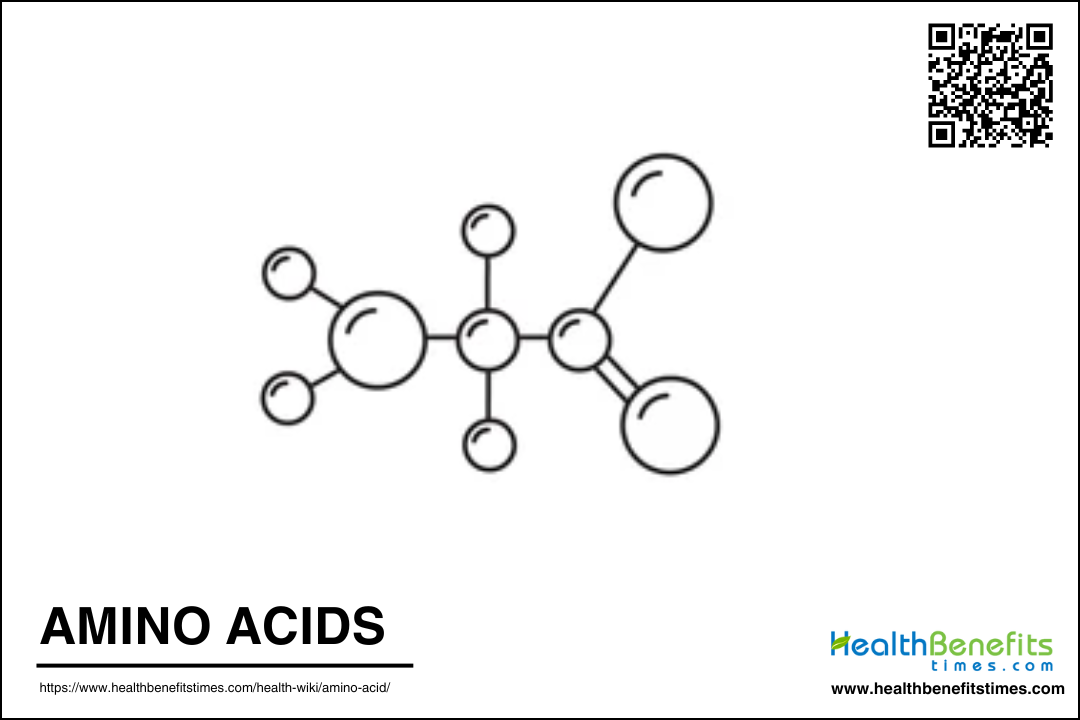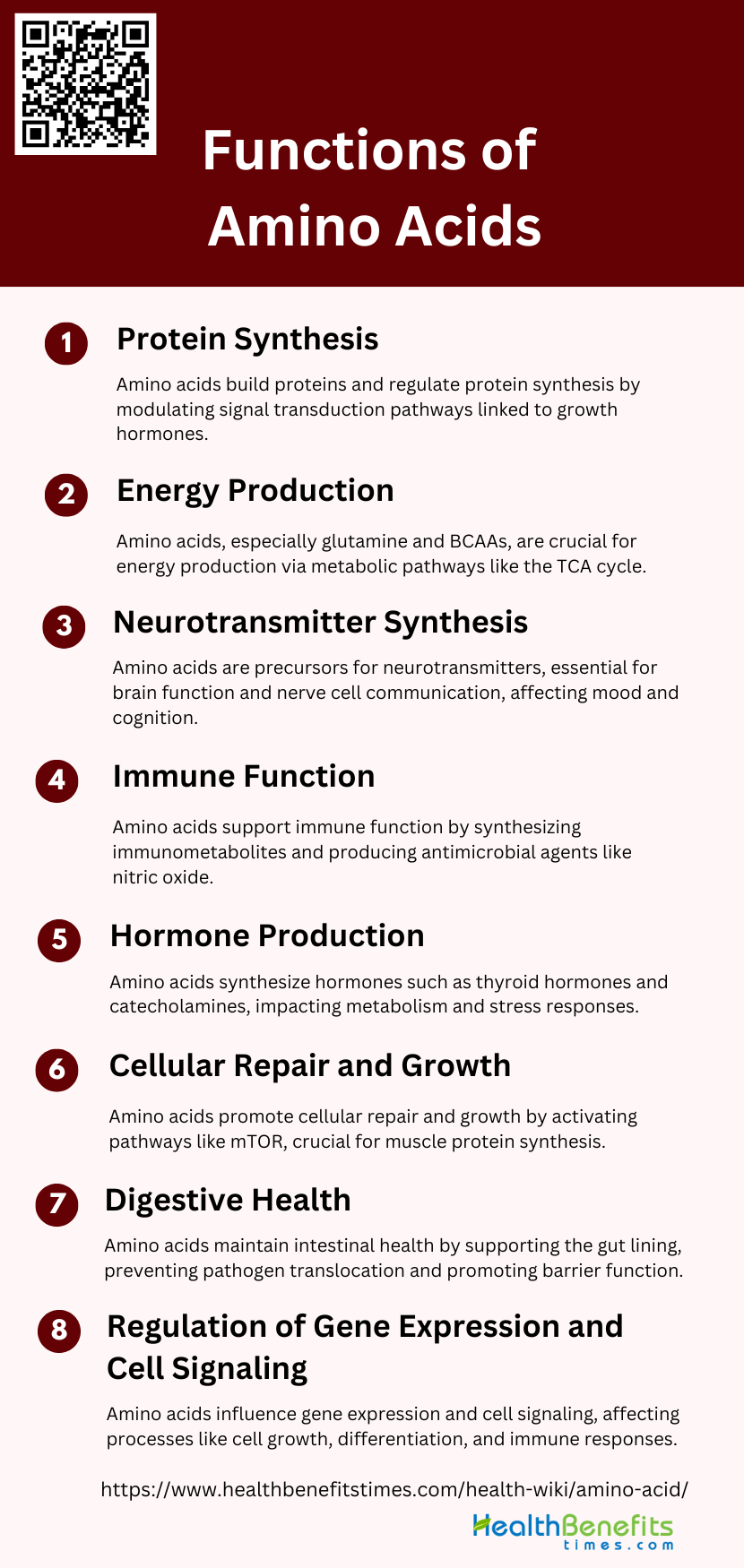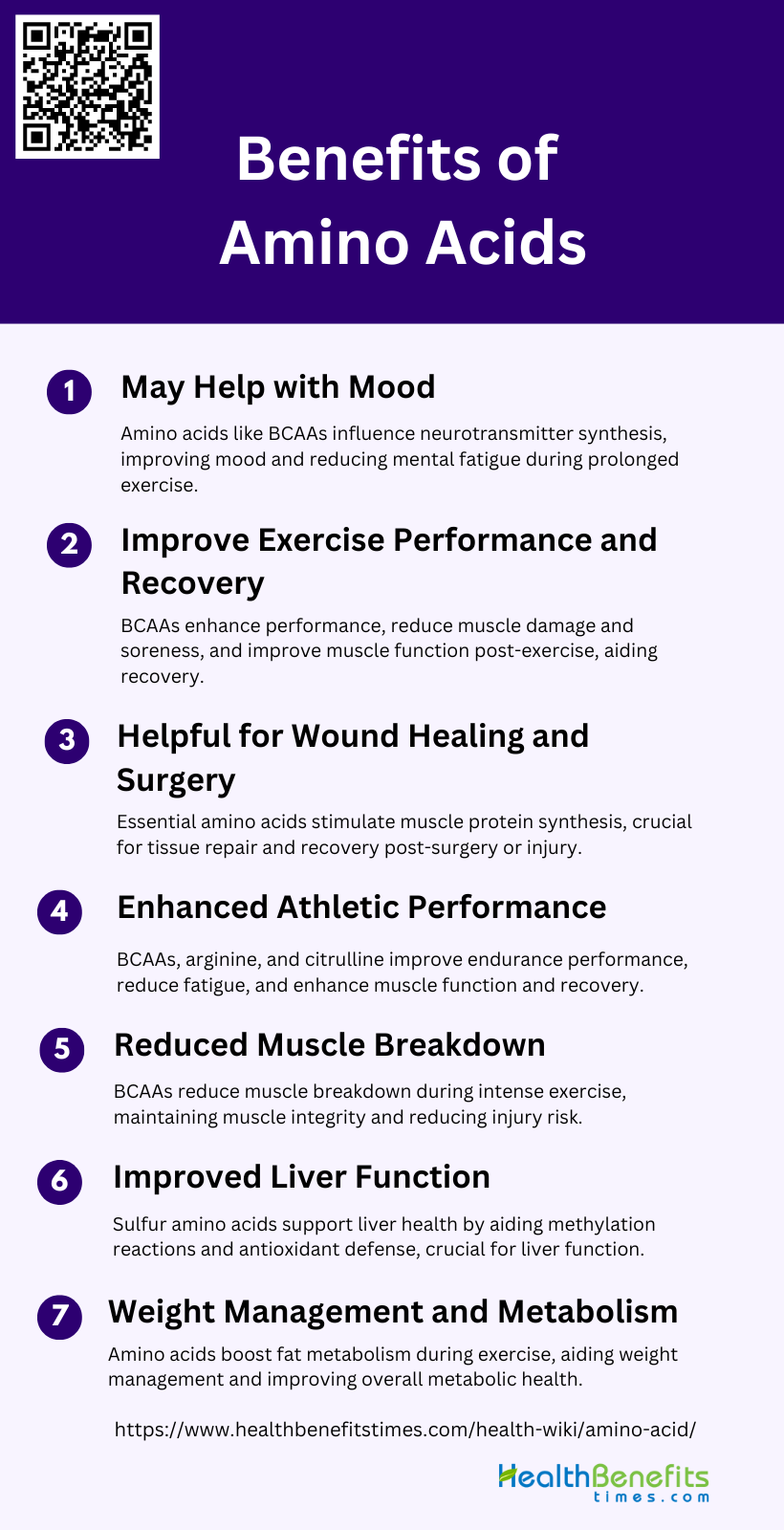An amino acid is an organic compound that serves as the fundamental building block of proteins. Each amino acid consists of a central carbon atom (alpha carbon) bonded to four key components: an amino group (-NH2), a carboxyl group (-COOH), a hydrogen atom, and a unique side chain (R group) that determines its specific properties. There are 20 standard amino acids used by living organisms to construct proteins, with 9 of these classified as essential amino acids that must be obtained through diet as the human body cannot synthesize them. Amino acids play crucial roles in various biological processes beyond protein formation, including neurotransmitter production, hormone synthesis, and energy metabolism. They can be found in a wide range of foods, particularly in protein-rich sources such as meat, fish, eggs, dairy, legumes, and certain grains
Types of Amino Acids
They can be categorized based on their nutritional requirements and chemical properties. Understanding the different types of amino acids is essential for comprehending their functions in the body. Below is a list of the amino acids:
- Alpha-Amino Acids
- Beta-Amino Acids
- Gamma-Amino Acids
- Delta Amino Acids
- Non-polar Amino Acids
- Polar Uncharged Amino Acids
- Aromatic Amino Acids
- Positively Charged (Basic) Amino Acids
- Negatively Charged (Acidic) Amino Acids
- Essential amino acids
- Non-essential amino acids
- Conditionally Essential Amino Acids
- Branched-Chain Amino Acids
- Sulfur-Containing Amino Acids
Functions of Amino Acids
They are the building blocks of proteins, which are vital for cell structure, function, and regulation. Additionally, amino acids are involved in metabolic pathways, neurotransmitter transport, and the synthesis of hormones and enzymes.
1. Protein Synthesis
Amino acids are fundamental to protein synthesis, serving as the building blocks for proteins. They are substrates for the translation process, where mRNA is decoded to produce specific polypeptides. Recent studies have shown that amino acids also modulate intracellular signal transduction pathways, which are typically associated with growth-promoting hormones like insulin and insulin-like growth factor-1. This dual role underscores their importance not only as substrates but also as regulators of protein synthesis.
2. Energy Production
Amino acids play a crucial role in energy production, particularly through their involvement in metabolic pathways. For instance, glutamine is metabolized via glutaminolysis to produce energy, while branched-chain amino acids (BCAAs) like leucine, isoleucine, and valine are used in the tricarboxylic acid (TCA) cycle for energy production. These processes are essential for maintaining cellular energy homeostasis and supporting various physiological functions.
3. Neurotransmitter Synthesis
Amino acids are precursors for several neurotransmitters, which are critical for brain function and communication between nerve cells. For example, tryptophan is a precursor for serotonin, a neurotransmitter involved in mood regulation. Similarly, glutamate, derived from BCAAs, acts as a major excitatory neurotransmitter in the brain. These roles highlight the importance of amino acids in maintaining neurological health and function.
4. Immune Function
Amino acids are vital for immune function, serving as substrates for the synthesis of immunometabolites and immunotransmitters. Glutamine, for example, is essential for the proliferation of immune cells and is metabolized to produce energy. Arginine is another critical amino acid, involved in the production of nitric oxide, which has antimicrobial properties. These functions underscore the role of amino acids in supporting the immune system.
5. Hormone Production
Amino acids are key precursors for the synthesis of various hormones. For instance, tyrosine is a precursor for thyroid hormones, which regulate metabolism, and for catecholamines like adrenaline, which are involved in the body’s stress response. Additionally, BCAAs have been shown to influence the secretion and action of hormones such as insulin, highlighting their role in endocrine function.
6. Cellular Repair and Growth
They activate signaling pathways that promote protein synthesis and inhibit protein breakdown. Leucine, a BCAA, activates the mammalian target of rapamycin (mTOR) pathway, which is crucial for muscle protein synthesis. This function is vital for maintaining muscle mass and promoting recovery after injury or exercise.
7. Digestive Health
Glutamine, for example, is a major fuel source for enterocytes, the cells lining the gut. It helps maintain the barrier function of the intestine, preventing the translocation of harmful pathogens and toxins. This role is particularly important in conditions like weaning-associated intestinal dysfunction and other gastrointestinal disorders.
8. Regulation of Gene Expression and Cell Signaling
Amino acids regulate gene expression and cell signaling pathways, influencing various physiological processes. Leucine, for example, modulates the mTOR pathway, which controls mRNA translation and protein synthesis. Other amino acids like arginine and glutamine also play roles in regulating gene expression and cell signaling, affecting processes such as cell growth, differentiation, and immune responses.
Benefits of Amino Acids
They are the building blocks of proteins and are vital for muscle growth, tissue repair, and overall health. Here are some key benefits of amino acids:
1. May Help with Mood
BCAAs can reduce cerebral serotonin synthesis by competing with tryptophan for crossing the blood-brain barrier, potentially reducing fatigue and improving mood during prolonged exercise. Additionally, amino acids like arginine and citrulline can help prevent hyperammonemia, which is associated with mental fatigue, thereby contributing to better mood and cognitive function during and after exercise.
2. Improve Exercise Performance and Recovery
Studies have shown that BCAA supplementation can reduce muscle damage, decrease muscle soreness, and improve muscle function post-exercise. Additionally, leucine-enriched essential amino acids (LEAAs) have been found to enhance muscle protein synthesis and recovery from muscle damage, making them beneficial for athletes undergoing high-intensity training.
3. Helpful for Wound Healing and Surgery
Essential amino acids (EAAs) stimulate muscle protein synthesis, which is vital for tissue repair and recovery. Studies have shown that EAA supplementation can improve muscle strength and function in older adults, which is particularly beneficial during recovery from surgery or injury. The anabolic effects of amino acids help in faster recovery and better healing outcomes.
4. Enhanced Athletic Performance
Amino acid supplementation has been shown to enhance athletic performance, particularly in endurance sports. A combination of BCAAs, arginine, and citrulline has been found to improve performance in consecutive days of endurance running by reducing fatigue and enhancing recovery. Additionally, amino acid mixtures can improve training efficiency by enhancing muscle function, reducing fatigue, and improving blood oxygen-carrying capacity.
5. Reduced Muscle Breakdown
Supplementation with BCAAs has been shown to maintain a net anabolic hormonal profile, reduce muscle cell damage, and decrease the risk of injury and illness during periods of high-intensity resistance training. This protective effect on muscle integrity is crucial for athletes and individuals undergoing rigorous physical activity.
6. Improved Liver Function
Sulfur amino acids (SAAs) are crucial for intracellular methylation reactions and cellular antioxidant defense, which are important for liver health. Studies have shown that post-exercise supplementation with carbohydrates and protein can improve recovery and performance by affecting plasma and urine concentrations of SAAs, thereby supporting liver function.
7. Weight Management and Metabolism
Specific amino acid mixtures, such as those containing arginine, alanine, and phenylalanine, have been shown to increase fat oxidation and improve lipid metabolism during physical activity4. This metabolic boost can help in weight management and overall metabolic health, making amino acids a valuable component of dietary supplements for fitness enthusiasts.
Foods high in amino Acids
Amino acids are the building blocks of proteins, essential for various bodily functions, including muscle growth, immune response, and enzyme production. Incorporating foods rich in amino acids into your diet can help ensure you meet your nutritional needs. Here are some foods high in amino acids:
1. Meat and Poultry: Beef, chicken, and turkey are excellent sources of essential amino acids.
2. Fish and Seafood: Tuna, salmon, and shrimp provide a high amount of amino acids.
3. Dairy Products: Milk, cheese, and yogurt are rich in amino acids.
4. Eggs: Eggs are a complete source of protein, containing all essential amino acids.
5. Legumes: Beans, lentils, and chickpeas are good plant-based sources of amino acids.
6. Nuts and Seeds: Almonds, walnuts, and chia seeds are high in amino acids.
7. Soy Products: Tofu, tempeh, and edamame are excellent sources of amino acids for vegetarians and vegans.
8. Whole Grains: Quinoa, brown rice, and oats contain a good amount of amino acids.
Deficiency of Amino acids
Recognizing the symptoms of amino acid deficiency is crucial for timely intervention. Here are some common effects of amino acid deficiency:
1. Edema: Amino acid deficiency can lead to edema, causing fluid retention and swelling in tissues due to impaired protein synthesis.
2. Anemia: Lack of amino acids affects hemoglobin production, leading to anemia characterized by fatigue, weakness, and pale skin.
3. Insomnia: Insufficient amino acids disrupt neurotransmitter balance, potentially causing insomnia and difficulty maintaining a regular sleep pattern.
4. Diarrhea: Amino acid deficiency can impair gut health, leading to digestive issues such as diarrhea and poor nutrient absorption.
5. Depression: Amino acids are crucial for neurotransmitter production; their deficiency can contribute to mood disorders like depression.
6. Hypoglycemia: Inadequate amino acids affect glucose metabolism, potentially leading to hypoglycemia, characterized by low blood sugar levels and dizziness.
7. Loss of Appetite: Amino acid deficiency can result in a decreased appetite, leading to inadequate nutrient intake and weight loss.
8. Fat Deposit in the Liver: Lack of amino acids can cause fat accumulation in the liver, leading to conditions like fatty liver disease.
9. Skin and Hair Related Problems: Deficiency in amino acids can cause skin issues like dryness and hair problems such as brittleness and hair loss.
10. Headache, Weakness, Irritability, and Fatigue: Insufficient amino acids can lead to headaches, general weakness, irritability, and chronic fatigue due to impaired bodily functions.




